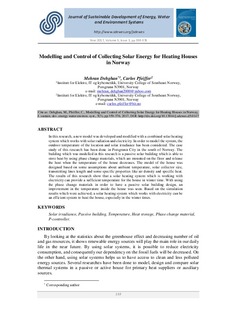Modelling and control of collecting solar energy for heating houses in Norway
Journal article, Peer reviewed
Published version
Permanent lenke
http://hdl.handle.net/11250/2479628Utgivelsesdato
2017Metadata
Vis full innførselSamlinger
Originalversjon
Dehghan, M., Pfeiffer, C., Modelling and Control of Collecting Solar Energy for Heating Houses in Norway, J. sustain. dev. energy water environ. syst., 5(3), pp 359-376, 2017, DOI: http://dx.doi.org/10.13044/j.sdewes.d5.0147 10.13044/j.sdewes.d5.0147Sammendrag
In this research, a new model was developed and modified with a combined solar heating system which works with solar radiation and electricity. In order to model the system, the outdoor temperature of the location and solar irradiance has been considered. The case study of this research has been done in Porsgrunn City in the south of Norway. The building which was modelled in this research is a passive solar building which is able to store heat by using phase change materials, which are mounted on the floor and release the heat when the temperature of the house decreases. The model of the house was designed based on some assumptions about ambient temperature, solar collector size, transmitting lines length and some specific properties like air density and specific heat. The results of this research show that a solar heating system which is working with electricity can provide a sufficient temperature for the house in winter time. With using the phase change materials in order to have a passive solar building design, an improvement in the temperature inside the house was seen. Based on the simulation results which were achieved, a solar heating system which works with electricity can be an efficient system to heat the house, especially in the winter times.

